

[originally published in the Fall 2000 issue of the Computers in Chemical Education Newsletter]
last update: 2001.03.04
Lectures, small-class sessions (sometimes called recitations or tutorials), reading and problem assignments have for many years been the four pillars on which the typical college course in General Chemistry is based; it is these components that I refer to as mainline instruction. (I will leave it to those with more direct knowledge to judge to what extent this applies to the variety of Chemistry courses offered at the secondary level.) Computers are now considered legitimate if not essential tools for extending our students' experience to such areas as visualization, molecular modeling, data collection and analysis, and simulations. More recently, various aspects of course management (automated homework administration, cooperative projects involving groups of students, and general management systems such as Web-CT) have been receiving increased emphasis.
Oddly, however, computers have won only marginal acceptance as a means of delivering the instructional "meat" of the course. It is true that many teachers recommend computer-based instructional materials to their students, either as dedicated computer-assisted instruction (CAI) lessons or in the form of the CDs that many publishers offer to institutions that adopt their textbooks, but in most cases these are treated as “learning aids” that play only a secondary and often discretionary part in instruction.
The reasons for this are many, but one of them, in my view, is that the benefits that well-designed CAI software can provide are unlikely to be realized unless it is carefully integrated into the overall course. This requires a re-thinking of the roles of each of the other tools of instruction in the context of CAI. Treating CAI as merely an "add-on" to an existing and unchanging regime of classroom activities and assignments will practically guarantee its failure to make any significant difference.
My purpose in this article is to expand on this by examining how CAI can interact with, and exert a perturbation effect on the other components of the course. The opinions I express are based largely on my own experience as both a user and author of instructional software; CAI has been an important tool in my General Chemistry courses since the 1970’s, and by the time I retired from teaching last year, it had become the principal means of delivering instruction in these courses.
|
Each of the traditional instructional tools we use— lectures, small-class discussions, problem solving, and of course, reading— has its own strengths, but each also possesses limitations. The sum total of all of these largely defines what the overall course is likely to accomplish in terms of student learning. CAI has its own limitations, but most of these can be mitigated by the stronger features of the traditional tools that are commonly retained in the course. On the other hand, CAI brings with it a number of potential advantages that cannot ordinarily be realized in conventional instruction. Thus a course in which CAI plays a significant role has the potential to yield better learning outcomes than is possible without CAI. In short, CAI can help change what is taught and how it is taught. |
||||
Adding CAI to the traditional mixture of instructional methods
|
||||
|
Most educational theorists now agree that we learn by creating our own knowledge as a result of our own questioning and experience, rather than by having it poured into our heads from the outside. We learn, at least at the concrete level, by building upon a conceptual framework that has developed from our accumulated life’s experience. This is essentially an incremental process in which each new idea or piece of information must be interpreted and related to what we already know before it can be incorporated into the framework, thus extending it and making it receptive to further information. A skilled teacher will unconsciously act in accordance with this principle, for example by employing the Socratic method of asking a series of questions that lead the students to discover the answers for themselves. Although some elements of this approach can be incorporated in lecturing and in textbooks, these methodologies tend to emphasize “telling” rather than questioning, thus failing to encourage the students’ taking an active part in the process. Students also vary greatly in the rate at which they can advance from one piece of information to the next, so the Socratic approach generally works well only in one-on-one instruction. |
||||
CAI is of course a form of “pseudo”-one-on-one instruction that is ideally suited to the cycle of asking a question, requiring the student to respond, and reinforcing or expanding on the desired response. In my view, this is by far the strongest feature that CAI has to offer, and it must be exploited as fully as possible if CAI is to assume a major role in the delivery of instruction..
Once this is accomplished, CAI becomes a powerful tool that can materially affect the scope and role of the traditional components of the course. In the following paragraphs we will take a closer look at some of these components, and consider what aspects of them can be transferred to or realized within CAI, and what particular strengths they retain and ought to be exploited in a CAI-based course.
In theory, a book (whether real or virtual) is the only thing a student should need in order to acquire the information necessary to meet the requirements of a course. In practice, few students are likely to find this medium entirely satisfactory, even if they are able to read for understanding, which all too many cannot. Although most of our students possess basic literacy, many lack the experience or perhaps even the desire to utilize it effectively. Those who lack an understanding of punctuation or are unable to recognize and interpret dependent clauses may be able to go through the motions of “reading the words” and little more. Even if these basic skills are present, a certain amount of discipline is required to coordinate the material contained in the body of the text with equations, examples, side-bar, illustrations, and problems.
Reading is of course a major part of most CAI lessons; even those that rise above the level of being “page turners” must present some information as displayed text. However, delivery of text by CAI offers some special advantages that, if successfully exploited, provide a nice complement to the textbook. Perhaps the major one is focus. To the student, all the book is available at once, with sentence following sentence and paragraph following paragraph, all interspersed (in most present-day texts) with interesting but distracting illustrations and sidebars. In CAI, however, the text can be presented in controlled increments, one idea at a time, with an opportunity for interaction and reinforcement before the next idea is introduced. In this respect, the computer-as-automatic page turner need not be as pejorative as it might first appear; along with the page-turning, there is the finger of the instructor pointing at the significant items on each page, relating one to another, and forcing the student to make some of these connections before proceeding to the next. In many ways, textbooks and CAI as reading sources serve complementary needs, and each can be of greater value in the presence of the other.
As for the textbook itself, I stopped specifying a "required" text for my 2-semester General Chemistry course many years ago. (See my polemic "Terminating the Textbook" for more on this.) Students are advised to acquire a text of some kind for reference purposes, but the course is never tied to any particular one. All of the reading assignments are drawn from a set of materials that I developed over the years and which are packaged and printed for each course. More recent versions of these have incorporated some of the same graphical images (mostly quite simple) that are seen in the corresponding CAI lessons, thus making it much easier for students to review the the topic off-line. Some of these text sets are available for download from http://www.chem1.com/chemed/digtexts.shtml.
Much the same can be said for verbal communication through lectures and similar classroom activities. There is probably no better tool than the formal lecture for presenting the broad picture of a subject, laying out the ways in which its various sub-topics developed and relate to one another, and in generally communicating the instructor’s enthusiasm. On the other hand, numerous studies have shown that lecturing is one of the least effective methods of bringing about learning. Other classroom techniques, such as directed problem-solving and cooperative learning groups have met with some success, but they are all limited by the very large differences in the rates that individual students are able to assimilate the material. Another limitation is time; there is rarely enough of it to deal adequately with all of the topics in the course, so many are simply dropped by default.
Classroom time is usually a limited commodity which most teachers would prefer to devote to activities such as discussions and demonstrations that build interest and provide motivation. Perhaps the major benefit of CAI to the teacher is to allow more flexibility in the use of class time by taking on some of the more routine aspects of instruction such as exercises and drills which are often not well adapted to class instruction anyway.
My own favorite example of this is the balancing of oxidation-reduction equations, a necessary but dreary topic which I have found can be taught entirely be CAI to the relief of everyone concerned. A good use of the classroom time regained is to discuss biological oxidation-reductions and the origin of atmospheric oxygen... something that I rarely had time for in the past.
Similarly, the 1.5 lectures I once devoted to VSEPR theory were reduced to about 20 minutes, in which I discussed its origins, the theory behind it, and its limitations. The task of actually learning to apply the theory to the usual variety of structural types was handled quite adequately and far more effectively by CAI lessons on the topic. Finally, I had time to say something about buckyballs and dendrites!
| One thing I never succeeded in doing in lecture was to get the class able to interpret pseudo-3D P-V-T graphs, something I consider essential for a proper conceputal understanding of the ideal gas laws. On a subsequent exam, most students were simply unable to get it right. (They seem to have enough trouble taking proper notes in two dimensions, let alone three!)
A short CAI-based lesson (now a part of my set on the gas laws) made a significant difference. In this lesson, students were asked to identify the different axes on this graph and to locate the lines representing the various functional relations between the variables. |
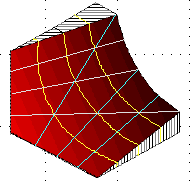 |
|||
The justification for organizing recitation and tutorial sections has always been to provide a forum in which students can interact more directly with an instructor and with each other than is ordinarily practical in the larger and more formal lecture session. With a skilled group leader and a small number of prepared and motivated students, these small classes can work very well, but the more usual situation is somewhere midway along the continuum between this ideal and the totally disfunctional class in which an inexperienced teaching assistant must face a group of students who come unprepared, will not ask questions, and often will not even answer questions. Students coming from cultures in which "losing face" is a real fear often resist actively participating in class discussions, as do many others who are simply unprepared or who feel uncomfortable asserting themselves in a group. The result is all too often a passive group of students who sit there waiting to be "taught", but unwilling to make any overt contribution to the process, often preferring to sit in the back rows, hoping not to be called on by the instructor, who is often reduced to giving mini-lectures.
At the risk of exposing my own deficiency as a teacher, I must admit that I consider the hundreds of hours I have spent conducting tutorial sessions for my General Chemistry courses over the years to be of no more than marginal value to most of the students, and a poor use of my time and theirs. A large part of what small-group classes are for can undoubtedly be provided by CAI lessons, especially those built around homework-style problems. It has been my impression that those students whose native language is not English have seemed to be the most enthusiastic CAI users, and I think this is significant.
I was about to give up on tutorials completely (as my department has subsequently done in response to space and budget constraints) when, about four years before I retired from teaching, I began holding the classes in a nicely designed computer lab equipped with about 60 workstations. The latter were used to deliver what were advertised as computer-based "quizzes", but which were really just devices to motivate the students to attend and to get them engaged with the material. The general topics each week's quiz were announced in advance, and students were allowed to bring books and notes, to ask questions of the instructor, and of each other. It was these last provisions that really seemed to transform the class into an active learning experience; the same students who would keep as low a profile as possible in a regular class could be seen helping their neighbors and participating in spirited discussions with their peers. Similarly, I probably answered more direct questions from students during one of these computer-lab sessions than I did during an entire semester of the conventional class; evidently the hesitation that most students exhibited about asking questions in front of a class largely disappears when they call the instructor over to their workstation carrel. Finally, although "productivity" is a word that academics love to detest, it's worth noting that I was able to handle more than twice the number of students that would have been acceptable in a conventional tutorial class. It seems ironic that placing students in front of computer workstations would have as its major effect a significant increase in contact on the human level!
Problem-solving is an essential part of learning Chemistry, but it is also something that severely challenges the abilities and self-confidence of many beginning students. The traditional practice of assigning problems, having them marked and then discussing them in class suffers from several weaknesses, the most serious of which is that students rarely feel comfortable in bringing the individual difficulties they experience to the attention of the group, so they commonly just write down the solutions provided by the instructor and learn very little. My first application of CAI was a set of short lessons based on individual problems in which the relevant chemical principles are reviewed in the context of the problem itself (J. Chem. Educ. 1970 47 143). The hope was that by asking the same questions that the student should be asking, these exercises might serve as a model that would encourage proper analysis of the problem, and thus discourage the common approach of searching for the right "formula" to substitute numbers into. Although the degree to which this can be achieved was never really tested, there is no doubt that most students found the exercises useful, and I was able to assign problems of a greater variety than was previously the case. There was also a significant reduction in the number of students seeking help with their problems. It is perhaps significant that I continued to get questions from the "A" and "D" students, and I was able to offer them more of my time than would have otherwise been possible, so this is another way in which the use of computers has allowed an increase in student-instructor contact.
In the CAI problem-tutorial context, there seems to be little need for marking, which we were cutting back on anyway as funds for TA's decreased. A commonly expressed reason for grading homework problems is to encourage (i.e., coerce) students into doing them, but I was never able to detect any difference at all in exam performance after I stopped grading problems in the early 1980s. Students were told that they are responsible for understanding the solutions to all of the assigned problems, and that similar ones would appear in both the midterm and final exams.
The problem tutorial lessons described above were originally developed on a mainframe system in the 1970s and found extensive use in several of my courses. In the mid-1980s they were developed into Chem1 Problem Proctor, a commercial product for the IBM-PC, consisting of 150 lessons based on that number of problems organized into 20 problem sets. Being of pre-Windows vintage, they are now stylistically obsolete, but they can still do their job.
It is essential that students have a clear idea of what they should be doing at any time during the semester. In a traditional lecture-based course, a simple list of the textbook chapters covered during each week is often sufficient, but when the course is not tied to a single textbook and additional resources such as CAI come into play, more detailed documentation becomes necessary. For the courses I have described, this includes:
The following table presents descriptions and examples of these documents.
| A well-thought-out set of Learning Objectives is essential for defining the course and directing the student's study and the instructor's planning. | 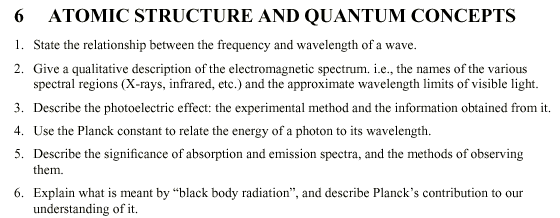 |
| This cross-reference sheet served as the student's main guide to the day-to-day activities associated with a beginner's course. In this case a textbook was used; the reading references are to Stoker's Introduction to Chemical Principles, 5th. Ed. Because the lectures are intended to supplement the other course material, the flow of the course is determined by the lectures and they can be scheduled in advance without worrying about timing. | 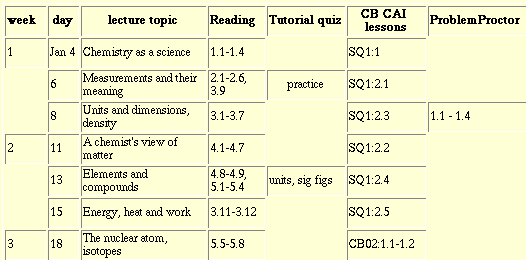 |
| This spreadsheet provides a global listing of the CAI Lessons available to the student, with the ones "required" for this particular course (again, a prep course for beginners) highlighted.
|
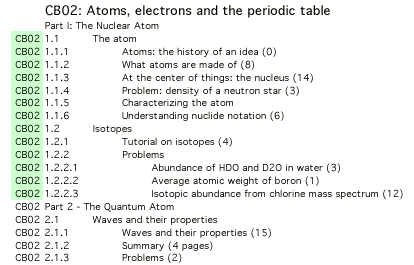 |
| Most of the assigned reading in the course comes from specially prepared material such as that shown here. This enables the course to be independent of the current fashions of textbook content and to supplement the student's own text. This particular excerpt is from the chapter Liquids And Their Vapors.
The Figure is similar to one seen in the corresponding CAI lesson. |
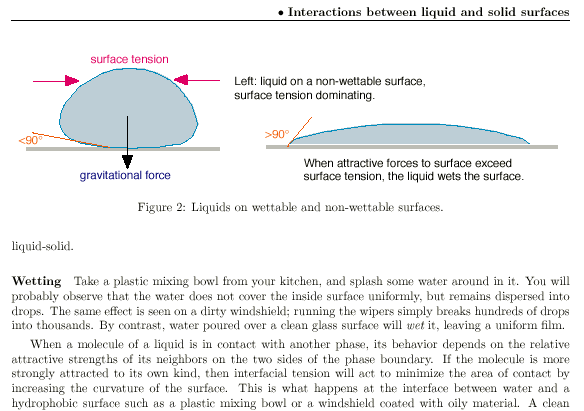 |
The interactive nature of CAI is without a doubt the key to its ability to mediate learning by the student. For “good” students, of course, reading a textbook and attending a lecture involve a degree of interaction with the medium, but these activities are likely to be fully exploited by only a minority of the typical class. More commonly, listening and reading tend to be largely passive activities that are separated in both context and time from the kind of active effort that is involved in problem solving, for example. Learning seems to be most effective when the passive and active aspects of the process are well integrated, and CAI is capable of bringing about this integrated to a degree that is probably greater than any other methodology save one-on-one instruction.
CAI, more than any other methodology, is able to actively engage the student with the material, forcing one to make decisions as the lesson progresses. Modern learning theory holds that knowledge is not simply something that can be poured into one’s head like a fluid, but must be constructed by the individual learner upon an existing framework which becomes able to assimilate more and more as it grows. A well-designed CAI lesson can aid this process by building on what the student already understands, extending it incrementally and always challenging the student to go a step farther-- very much what an experienced teacher would attempt to do in a one-on-one setting.
One objection that is commonly heard about CAI (or any other system of self-paced or distance learning) is that students are isolated both from the instructor and from their peers. If CAI were the only tool used for instruction, then there might be some substance to this, although the popularity of “open university” programs suggests that many students are quite willing to decouple their education from their social life. Most applications of CAI in fact occur in the context of a “course” in which student-instructor contact includes both classroom activity and direct consultation. In terms of hours per week, both kinds of contact are usually very limited, especially in large-enrollment courses, which often amount to “distance education” by another name. It is the experience of this author that well-designed CAI materials can markedly reduce the number of students showing up at his office door on the days preceding an examination. The students who do come tend to be the very bright ones (who always have questions) as well as some of the weaker ones who often require more help than the CAI lessons can provide, and to whom more time can now be devoted, thanks to CAI’s reducing the demand of the “average” students on the instructor’s time.
There is another social repercussion of CAI that is worth noting. Most institutions enroll substantial numbers of students coming from disadvantaged backgrounds, or who have problems with the language, or come from cultures in which “losing face” (through asking questions or being in danger of giving an incorrect answer in class) seriously inhibits participation in classroom activities. Students falling into these categories seem to benefit from CAI in two ways. First, they appreciate the freedom of being able to give the wrong answer “without anyone knowing”, and of course they do so freely, thus participating in the activity to a greater extent than they would otherwise. Secondly, by progressing through the lesson in this way (and being able to repeat it as often as required), they are likely to build a degree of self-confidence. One would even hope that a lesson that challenges the user with interesting questions would serve as a model for the kind of questioning that should be going on in the student’s own mind when tackling any subject, not just Chemistry. All of us who are teachers certainly know that the worst students are those who never have any questions; perhaps they never learned to ask them!
A major impact of any methodology in which the student interacts directly with the medium is to make the teacher more a manager of instruction, rather than its primary deliverer. When this works as it should, the effect is to allow the teacher to accomplish more with a given input of time and effort. “More” in this sense refers not only to the total amount of material taught, but also to the ability to minister to the individual needs of the students. As was pointed out in an earlier section of this article, if CAI can meet most of the needs of students of average background and ability, then the instructor has more time to devote to those having special needs.
Most teachers are well aware of the wide range of backgrounds and abilities among the students who come to us each semester. Even in a course such as the one I taught which carries two years of high school chemistry as a prerequisite, we get students who can barely do stoichiometry problems or cannot tell me what properties a block of wood must possess in order to float in water. There is little time do devote to these and similar topics in the course, and to do a thorough review would be rather dull for the half of the class that is adequately prepared. A set of CAI lessons specifically designed to bring students up to speed on fundamental topics such as these during the first three weeks of the semester has been invaluable in reducing the functional heterogeneity of the class, and there is reason to believe that it has reduced the number of students who get discouraged and drop out during this critical period.
| For details on the contents of this lesson set, see here. | |||
Even for more advanced courses, CAI can be helpful in overcoming differences in background. For example, second-year organic chemistry instructors usually expect their incoming students to have a good understanding of formal charge and hybrid orbitals. The amount of emphasis placed on these topics in the preceding General Chemistry course varies considerably depending on both the textbook and the instructor. A set of CAI lessons covering these topics can efficiently bring the class up to the required level with a minimum of diversion from the main subject of the course.
Another important area of CAI is in connection with the laboratory. One application is the need, obvious to almost anyone who has taught a laboratory course, to ensure that students come prepared with sufficient understanding of the procedure and the theory behind it. A pre-lab CAI exercise can help by requiring the student to assemble the material required (by dragging their images to the appropriate locations on the display screen), to take readings (of volumes, for example, using an image of a burette showing the liquid meniscus), and working up the raw data into a numerical result.
Stanley Smith and his associates at the University of Illinois have taken this farther by preparing simulations of entire experiments which can be used in place of “real” experiments. Although this strikes some chemistry teachers as heretical, a number of good arguments can be made for incorporating at least some such experiments into the lab course. The major benefit is that students can be exposed to a wider range of experiments, including those that would be too complicated, expensive, or dangerous to perform in the laboratory. Also, experiments that have already been performed can be repeated several times in simulation to observe the effect of changing temperatures, concentrations, or other parameters.
These materials and others like them are now available commercially. Some institutions find it practical to have students do “wet” and “dry” labs on alternate weeks, thus doubling the effective capacity of lab space which is frequently in very short supply.
As CAI becomes more widely employed within a department, there can be more flexibility in terms of course prerequisites and in offering low-enrollment courses in which regular lectures might not be justified. Taken to the extreme, this could bring some aspects of academic education closer to the industrial training model in which CAI allows students to begin the study of a specialized topic whenever it is convenient to do so, and to proceed at their own pace.
Many institutions are also exploring distance education, either as a component of their regular teaching program or as an outreach to students who would not otherwise be able to attend on-campus classes regularly. CAI, combined with a good course management system and access to a tutor through telephone or E-mail, and be a major component of such as course.
In this article I have tried to show how CAI can make a real difference to teaching and learning, but I must make the point once again that this does not happen by magic, and that a lot of restructuring of a traditionally-taught course must be done in order to realize the potential of this tool. A subsequent article will examine some other aspects of integrating CAI into a course, and will provide examples of several instructional strategies that can be incorporated into CAI programs.
See my list of commercially available CAI programs and also the Chemical Education Resources Shelf which contains a special section devoted to instructional software.
"Systems and software for putting your course on the Web" by S.K. Lower (HTML document) - provides an overview of authoring systems, course management systems, and server-based systems for delivering content.
Resources for chemical education - a selective, annotated collection of links for teachers and students.
 |
||||||
|
© Stephen Lower is a retired member of the |
||||||
|
Last modifed |
||||||